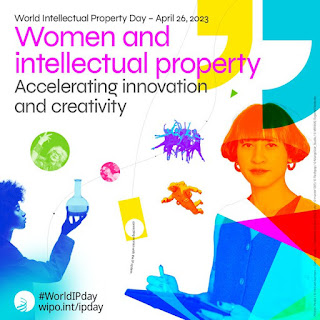Women And Intellectual Property
“Even though women have shape intellectual property, law and policy they are underrepresented today as inventors. Narrowing gender gaps in trade and intellectual property is morally overdue and smart economics.”- Dr Ngozi Okonjo-Iweala, Director General, World Trade Organization (WTO).
The world’s first copyright law was the Statue of Anne, enacted in England in 1710 by Queen Anne of Great Britain. Every year on April 26th, the World Intellectual Property (IP) Day is celebrated. The international campaign presents a special opportunity each year to join forces with people all around the world to celebrate innovators and creators globally and discover how IP supports a flourishing music and arts scene and boosts technological innovation that helps shape our world. WIPO states that the celebrations this year will focus on all talented women around the world in an effort to promote the development of more inclusive and diverse IP ecosystems that accelerate innovation, creativity and business growth for the benefit of all. In must be noted that women through their creativity, intelligence, and hard work, are reshaping the world in all regions. However, women frequently face major challenges to access the knowledge, skills, resources, and support they need for success.
What is Intellectual Property?
The World Intellectual Property Organization (WIPO) defines Intellectual Property (IP) as the creations of the mind, such as inventions; literary and artistic works; designs; and symbols, names and images used in commerce. For example IP is protected by patents, copyright and trademarks, which enable people to earn recognition or financial benefit from what they invent or create. By striking the right balance between the interests of innovators and the wider public interest, the IP system aims to foster an environment in which creativity and innovation can flourish.
Types of Intellectual Property
Patents
A patent is an exclusive right granted for an invention. Generally speaking, a patent provides the patent owner with the right to decide how or whether the invention can be used by others. In exchange for this right, the patent owner makes technical information about the invention publicly available in the published patent document.
Copyright
Copyright is a legal term used to describe the rights that creators have over their literary and artistic works. Works covered by copyright range from books, music, paintings, sculpture and films, to computer programmes, databases, advertisements, maps and technical drawings. The symbol © is used to indicate copyright.
Trademarks
A trademark is a sign capable of distinguishing the goods or services of one enterprise from those of other enterprises. Trademarks date back to ancient times when artisans used to put their signature or "mark" on their products.
Industrial Designs
An industrial design constitutes the ornamental or aesthetic aspect of an article. A design may consist of three-dimensional features, such as the shape or surface of an article, or of two-dimensional features, such as patterns, lines or colour.
Geographical Indications
Geographical indications and appellations of origin are signs used on goods that have a specific geographical origin and possess qualities, a reputation or characteristics that are essentially attributable to that place of origin. Most commonly, a geographical indication includes the name of the place of origin of the goods.
Trade Secrets
Trade secrets are IP rights on confidential information which may be sold or licensed. The unauthorized acquisition, use or disclosure of such secret information in a manner contrary to honest commercial practices by others is regarded as an unfair practice and a violation of the trade secret protection.
In Pursuit of Gender Parity
Unfortunately, in a world characterized by patriarchy and entrenched biases against women and girls it has become more challenging for women and girls to realize their innovative and creative potential. This reality is especially so for women and girls in Afghanistan where the Taliban led government have banned girls from receiving an education after primary schools. Women in Afghanistan are also strongly encouraged not to work outside of their homes. According to the WIPO Director General Daren Tang, women only account for 3 in 10 jobs in the fields of Science, Technology, Engineering and Mathematics (STEM). Despite making up more than half of the world’s population women only account for 16% of international patent applications. This is problematic and needs to change. On this World Intellectual Property Day the clarion call is for the international community to join forces in order to make gender parity in intellectual property a reality. The global community must work towards a more inclusive universal IP culture in order to transform our world. Let us continue to give support to women innovators and creators in using intellectual property in their journey from mind to market. This support is critical as the world emerges from the COVID-19 pandemic where many individuals lost their jobs and livelihoods. Women should be encouraged to pursue their passions and creative dreams. A balanced intellectual property system will assist in ushering a more stable global financial system and help with the creation of jobs in this post- pandemic period. The work of all stakeholders is needed as the international community observes World Intellectual Property Day.
Wayne Campbell is an educator and social commentator with an interest in development policies as they affect culture and or gender issues.
waykam@yahoo.com
@WayneCamo
©
#WorldIPDay



Comments
Post a Comment